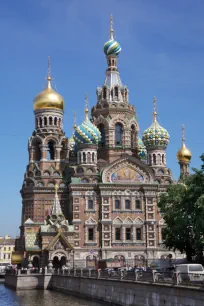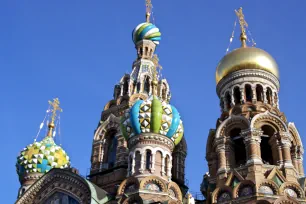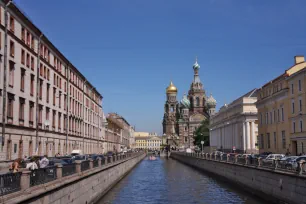The magnificent Church of the Savior on Spilled Blood is one of St. Petersburg’s most memorable landmarks. The church, built at the end of the nineteenth century, is constructed in a classical Russian style decorated with colorful domes and glazed tiles.

Background
Officially consecrated as the Church of the Resurrection of Christ, the Russian Orthodox gem more commonly known as the Church of the Savior on Spilled Blood was built to honor Tsar Alexander II of Russia, who was assassinated at the site where the church now sits, hence the reference to “spilled blood”. The section of the street on which the assassination took place is enclosed within the walls of the church, and the site of the murder is marked by a chapel in the building.
At the request of Alexander III, son of Alexander II, construction on the church began in 1883. Funding for this amazing structure was almost totally provided by the Imperial family, with other donations made by private individuals. The project was completed in 1907.
The Architecture
The principle architect chosen for the project was Alfred Alexandrovich Parland, who was, incidentally, a non-Russian-born individual. The architecture of the church varies greatly from other buildings and religious structures in St. Petersburg, which were largely constructed in the Baroque and Neoclassical styles. However, the era in which Church of the Savior was built was a time of resurgence of nationalism, thus the classic Russian style of the church.


Looking at both the interior and exterior, it’s easy to see why the church cost about 4.6 million rubles, way over the budgeted 3.6 million. The outside was designed to mirror the magnificent St. Basil’s in Moscow, the city’s easily-recognizable centerpiece, and the building – both inside and outside – features about 7,000 square meters of mosaics, most of them designed by the prominent artists of the time, including Viktor Vasnetsov, Mikhail Nesterov and Mikhail Vrubel. The majority of the mosaics depict biblical scenes and saints, though some are just patterns. The colorful onion domes, of which the central one reaches a height of 81 meters (266 ft), are covered with bright enamels.
The Church after the Revolution
During the Russian Revolution of 1917, much of this amazing church was ransacked, and the interior was seriously damaged. In the 1930s, the Soviets closed the church, as they did with most churches in St. Petersburg. During World War II, it was used as a storage facility for food. If suffered yet more damage during the war, and afterward, was used for many years as storage space for a local opera company.
In 1970, St. Isaac’s Cathedral assumed management of the church, and funds garnered from the cathedral (which was, at that time, a museum) were used to restore the Church of the Savior. Restoration was finally complete in 1997 and remains one of St. Petersburg’s top tourist attractions.

